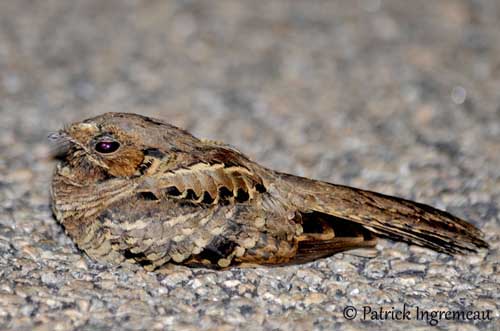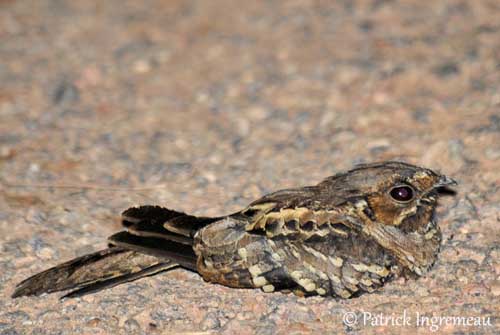
Fr: Engoulevent pauraqué
All : Pauraquenachtschwalbe
Esp : Chotacabras Pauraque
Ital : Succiacapre collobianco
Nd : Pauraque
Sd : Azteknattskärra
Port: Bacurau
Photographers:
Marc Chrétien
MURINUS
Tom Grey
Tom Grey's Bird Pictures
Patrick Ingremeau
TAMANDUA
Text by Nicole Bouglouan
Sources:
HANDBOOK OF THE BIRDS OF THE WORLD Vol 5 by Josep del Hoyo-Andrew Elliott-Jordi Sargatal - Lynx Edicions - ISBN: 8487334253
A GUIDE TO THE BIRDS OF MEXICO AND NORTHERN CENTRAL AMERICA by Steve N. G. Howell, Sophie Webb - Oxford University Press - ISBN: 0198540124
A GUIDE TO THE BIRDS OF COLOMBIA by Steven L. Hilty and William L. Brown - Princeton University Press – ISBN 069108372X
BirdLife International (BirdLife International)
Wikipedia, the free encyclopaedia
Pauraque
Nyctidromus albicollis
Caprimulgiforme Order – Caprimulgidae family
BIOMETRICS:
Length: 22-28 cm
Weight: 43-90 g
DESCRIPTION:
The Pauraque is a nocturnal bird. We can find two morphs, grey and rufous, both very cryptic.
Adult male in grey morph has greyish-brown tinged rufous upperparts with brown mottling and greyish-white speckles. The upperwing pattern shows chestnut to greyish-brown feathers with brown speckles and conspicuous buff spots. Scapulars are blackish-brown with buff edges and tips.
In flight, the male shows blackish wingtips and fairly broad white wing band. On the tail, the two outermost rectrices are largely white.
The underparts are similar, greyish-brown with rufous tinge, with brown and buff markings on belly and flanks. There is a white throat patch, sometimes restricted to small white spot on lower throat side.
The wings reach about half the tail length at rest.

On the head, the central crown is broadly streaked brown. The nuchal collar is absent. Eye-ring and submoustachial stripe are buffish. Lores and ear-coverts are rufous or chestnut.
The bill is blackish. The eyes are dark brown. The short legs and the feet are greyish.
We can find a less common rufous morph with overall tinged rufous-cinnamon plumage coloration.
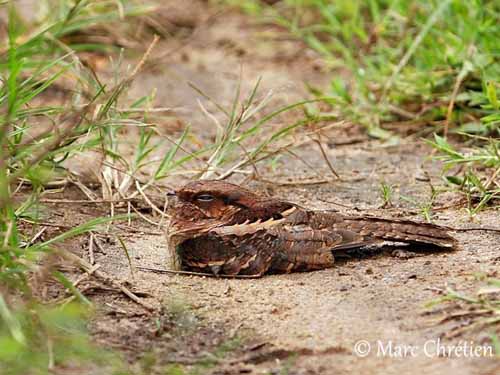
The female has narrower white wing bands which are tinged buff or tawny. The tail feathers show less white than in male.
The immature resembles adult with thinner white wing bands in young male and tawny bands in young female.
There are seven subspecies which may vary in size and coloration, and extent of white in tail in males of some races.
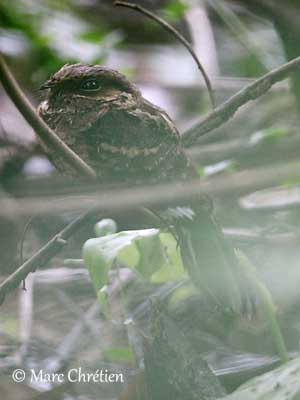
VOICE:
The Pauraque gives loud whistles all year round “p’weeEER” preceded by one or more clucks “puc, puc, puc, puc p’weeEEr”. We can also hear a repeated “p’weeer, p’weeer…” or “whee’oo, whee’oo…”, and rarely a longer “poo wee-ee-oo’oo”.
The male’s song is variable and given from the ground or perches while bobbing nervously.
The calls include a great variety of sounds such as clucks, guttural hissing sounds, rattles and grunts, often uttered during the distraction displays.
HABITAT:
The Pauraque frequents forested country, forest edges and clearings, open woodland and plantations, but it is also found in scrubland, crop fields, semi-arid regions, marshland and mangroves.
This species is visible from sea-level to 2300-3000 metres of elevation.
RANGE:
The Pauraque breeds from extreme S USA and NE Mexico, through Central America, S to NE Argentina. Most of races are resident in their range, except the US breeders of the race “merrilli” which may winter in E Mexico.
BEHAVIOUR:
The Pauraque feeds on a wide variety of insects caught by short sallies to the air from the ground, but also by flycatching from low perches.
It also hunts by flying over open areas, hawking for preys close to the ground.
This species is strictly nocturnal. It may be seen by day accidentally if flushed from the vegetation where it is resting.
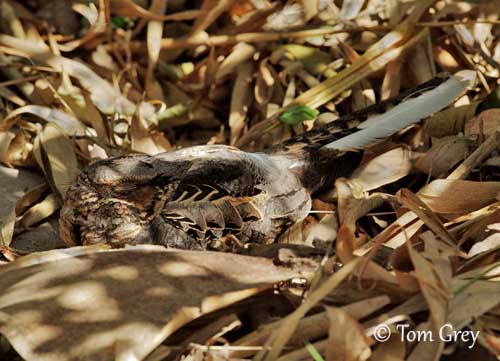
The Pauraque performs distraction displays if threatened at the nest-site. The adult performs injury-feigning display to protect the chicks and to attract the predator away from the nest.
At the beginning of the breeding season, the male sings loudly to attract females into the territory. It defends it strongly against rivals and intruders.
Then, the male displays to the female, displaying the white parts of throat, wings and tail. Courtship may take place on the ground or on perch, but also often in the air.
FLIGHT:
The Pauraque has large wing area which allows it to pursue and capture flying insects.
Nightjars are usually excellent fliers and extremely agile in the air.
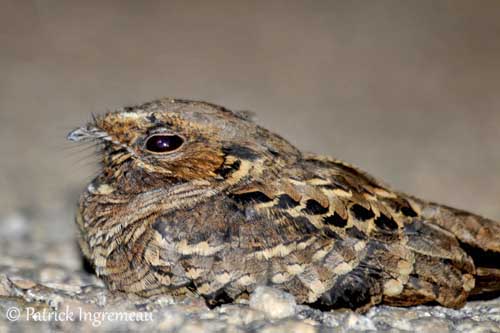
REPRODUCTION:
The breeding season varies according to the range.
The Pauraque establishes the nest-site at base of bush or low tree, usually in a small open area, a clearing in thicket, or along a roadside in forest, in low or among scattered vegetation, pasture, field, or among boulders or stones.
The eggs are laid on the ground on leaf litter, pebbly sand or stony ground.
The female lays 1-2 pale eggs with dark markings, or sometimes unmarked. The male incubates mainly during the day, and this period lasts about 19-20 days.
The Pauraque is preyed upon by feral dogs and cats, and the eggs are sometimes eaten by small mammals, birds and reptiles.
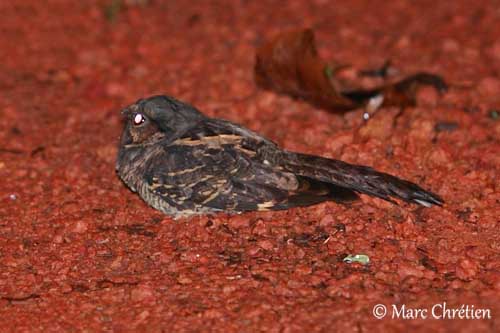
DIET:
The Pauraque feeds on numerous insect species such as beetles, moths, butterflies, bugs, bees, wasps, ants and orthoptera.
It catches flying insects by short sallies in the air from the ground or perches.
PROTECTION / THREATS / STATUS:
The Pauraque is fairly common or abundant in most parts of the range.
This species is not currently threatened.
